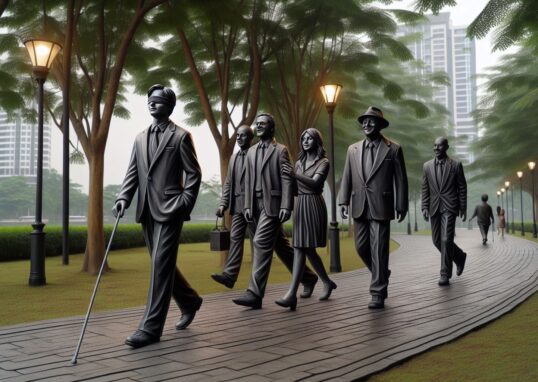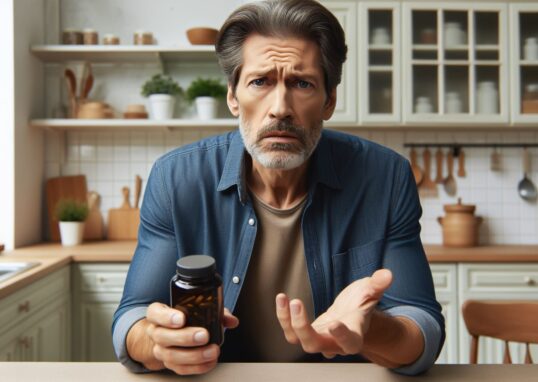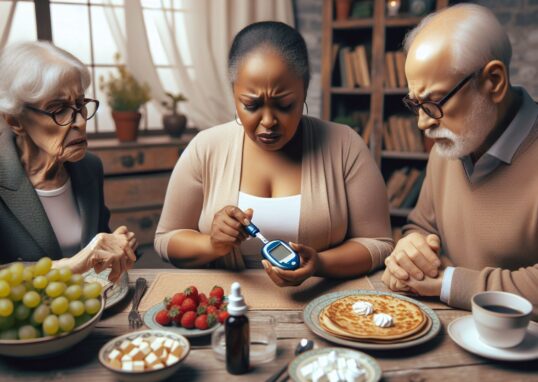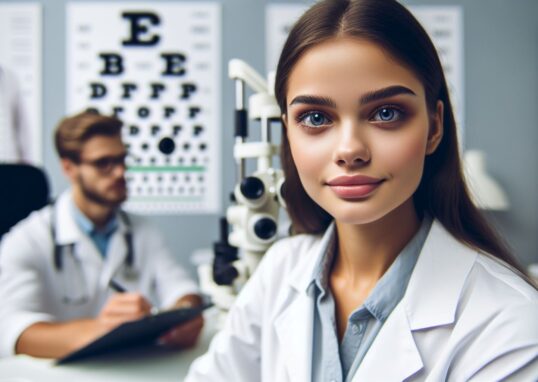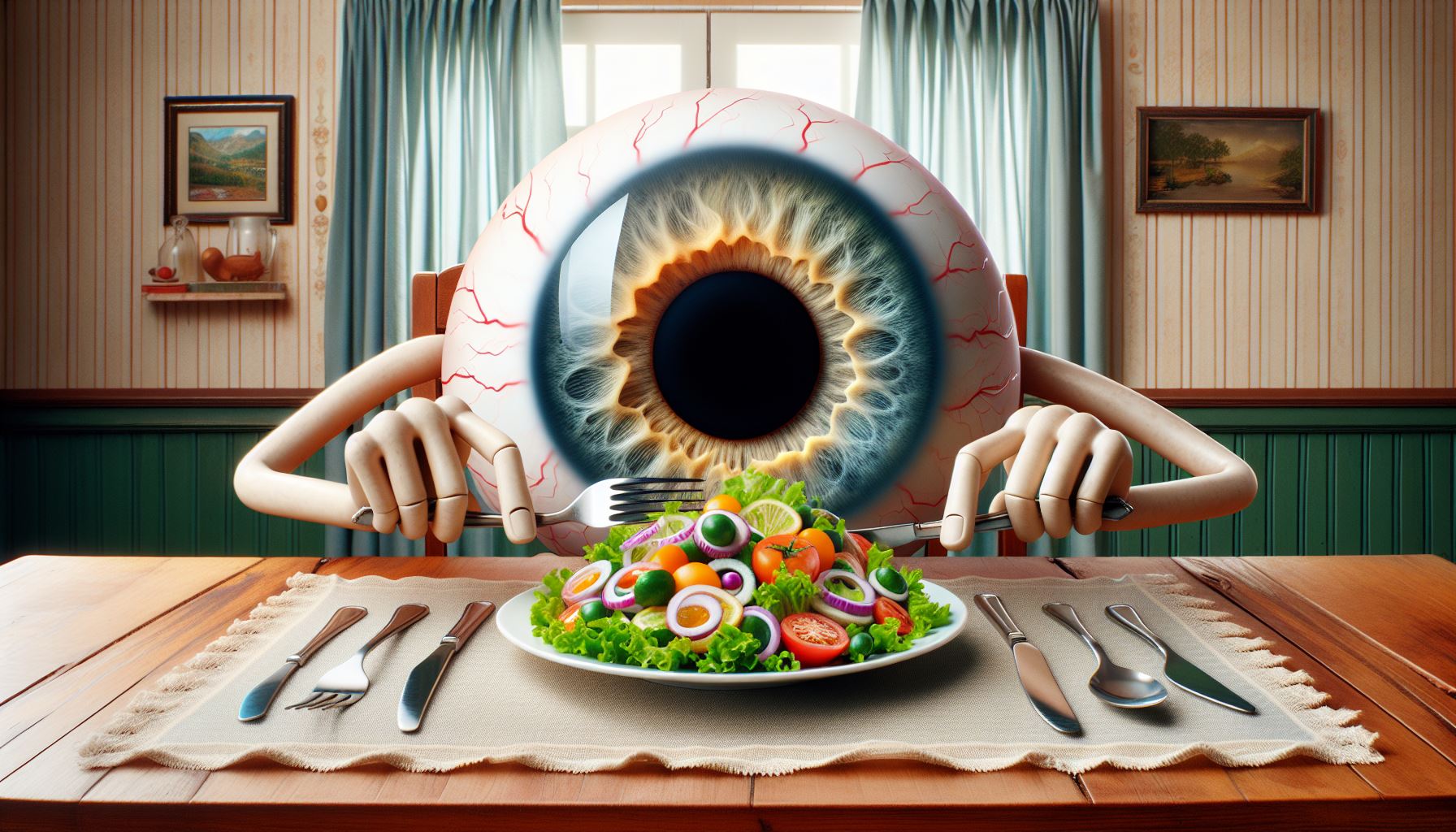
Living with macular degeneration is not an easy task, but the good news is that it’s possible to maintain a good quality of life. In this report, we’ll explore self-care strategies, lifestyle adjustments, and emotional well-being for individuals dealing with this condition. Additionally, you’ll read first-hand experiences from Sam, Elizabeth, Jack, Joan, and Lori, who have the disease. Finally, you’ll discover the professional insights from Dr. Dorothy Hitchmoth, Dr. Allen Taylor, Occupational Therapist Beth Daisy, Matthew Levine (AMDF) and Chip Goehring (AMDF). The American Macular Degeneration Foundation put together a short film called “Losing Sight, Finding Hope: Living with Macular Degeneration“, which includes the whole interviews from everyone quoted here.
– [Sam] Losing your vision makes you gain a deeper appreciation of your life,
especially if you have a degenerative eye disease.
Because you don’t know how many more sunsets you’ll see.
So I better enjoy this one.
Vision Loss Experience
Personal stories of living with vision impairment
– [Elizabeth] I was diagnosed at 15 or 16, and it had been years
of failing the eye tests at the elementary school. And they kept sending me,
my vision was probably 20/40, 20/60. Finally, at 15 or 16, they figured it out
when they saw a little bit of scarring on my retina. When most people think of
somebody that’s visually impaired, they think of the things that are like, oh,
I can’t read a book.
I can’t drive,
I can’t see a TV.
Maybe I can’t go to the movie theater. They don’t think about the little things
that are the most important. Like I have not been able to see my husband’s face,
my daughter or my son’s face. You know, all these years, I haven’t been able to see any of it.
I haven’t known exactly what they look like. So when I look at them, I’m just seeing their shadow.– [Jack] I never thought I would quit any of the martial arts that I do.
The term “martial art,” it was really more meant
to be learning to self-improve, to bring your nature to nature out.
It actually helped me to be a little more patient with my vision.
At first, I was frustrated with a lot of different things and stuff.
I wasn’t angry, I was just frustrated
I couldn’t do certain things. Macular degeneration on both eyes. I’m not blind, but I am blind.
I don’t see as well as most people with this. So again, when somebody says,
“You’re not looking at me,” it’s kind of a foolish thing, because I am.
In fact, I’m looking at him too. And in fact, I’m looking over there, and I’m looking over there.– [Sam] Hey there, my name is Sam, and I have macular degeneration.
We definitely live in a sight-first world.
It’s super difficult. Everything is set up for vision. Signs, I mean,
you know, do I pull on this door? Do I push? Well, there’s a sign there.
It’s probably telling me, but I can’t tell.
Although I was diagnosed at an early age, much like most people growing up with low vision,
I fought it tooth and nail. I didn’t want to be visually impaired. I wanted to be like all the other kids in my class
and my neighborhood, all my friends. And so I never fully accepted it until much later in life.
I can see faces better if I get close up to ’em, like uncomfortably close, (chuckles)
which isn’t very accepted in modern society. So I don’t see faces, in general.
In fact, I have no idea what most of my family looks like without using some type of assistive technology to do that.– [Joan] My name is Joan LeBaron,
and I have both wet and dry macular degeneration.
One eye is dry, and the other eye is wet. What happened was I would notice that at the top
of windowsills, or when I looked at things that were supposed to be straight, they weren’t.
So then I was referred to a retinal specialist.
Well, I have to say I was really more puzzled than anything else because I hadn’t really known that much about macular degeneration.
The fact that I may have to give up playing cards or not drive
are things that I am very sorry to think that I can no longer do, because I’m a person that likes,
I love to drive, I love to go places and do things, but that is something that I feel I have to adjust to,
but it’s normal. I’m older, I’ve done a lot of things,
been a lot of places, seen a lot of wonderful sites. I can still watch television, I can still do many things.
I can still listen to the books, so I’m not, I don’t dread the future.– [Lori] I’m a very active person,
and I love to do outdoor things. I hike, I garden.
I have beautiful gardens. We live on a river. I like to get in the canoe and canoe up the river.
One of our favorite things to do together with my husband and I is forage. We go out into the woods, and we bring our baskets,
our foraging knives, and out we go hunting mushrooms.
I was diagnosed about 10 years ago.
I went in for a routine eye exam, and the doctor
took a look at my eyes and said, “Had anyone ever told you that you had macular degeneration?”
And I said no. You know, I was familiar with that because my dad, at 80, had macular.
It was disbelief. You know, I thought, “Hmm, this is a mistake,” or, “Hmm, you know, maybe he thinks he sees something,”
but oh my gosh, my dad has it. He told me eat my spinach and take my vitamins and like that.
So it was about 7, 8 years later maybe, where things started to change for me.
The emotional impact of diagnosis
The Diagnosis Encounter: Imagine (or remember) sitting across from your doctor, heart racing, as they deliver the news: “You have macular degeneration.” The room seems to close in, and suddenly, your world shifts. How the doctor communicates this diagnosis matters profoundly:
- Blunt and Abrupt: Some doctors say it like ripping off a bandage—“You have macular degeneration.” No context, no empathy. It leaves you feeling isolated and overwhelmed.
- Lack of Information: You’re left in the dark. What is macular degeneration? What can you do? Without guidance, anxiety creeps in.
-
– [Jack] When I got out of the service, I was just told, “Go ahead and live with it.”
And I didn’t know anything about Blinded Veterans Association. I didn’t know anything about Massachusetts,
Vermont, New Hampshire’s blind associations.
I had no idea. So I just did the best I could.
-
- Negative Prognosis: “Irreversible vision loss.” Those words hang heavy. You need hope, not despair.
-
– [Elizabeth] I find that most of the time, somebody is diagnosed, and they’re just given this diagnosis
either at a retina specialist or a regular ophthalmologist, and they’re not given any
hope, or there are these options available. Why don’t you get in touch with this low vision specialist?
They have this equipment you might like. There’s just really not enough of that going on, and there are groups of people around the country
that are actually working to try to increase the knowledge for folks.
-
- Insensitive Language: Imagine hearing, “Your macula is degenerating rapidly.” But what does that even mean?
-
– [AMDF Matthew] Too often, the doctor says, “Well,
the images that we’ve just looked at, say, you’ve got macular degeneration, not much we can do for you right now. You might wanna think about taking
these vitamins, supplements. We’re gonna stay on top of it, so I’ll see you in a year.” That’s usually what happens.
The doctor should say, “By the way, if you have any questions about this, feel free to contact me or my nurse.
And you might also wanna think about it, watching your weight, et cetera.”
-
Having the right doctor for a macular degeneration diagnosis is key. They can detect the condition early, provide expert guidance, and ensure timely intervention. Their compassionate approach eases anxiety, making the journey more manageable for patients.
– [Lori] Having the right eye doctor for this diagnosis
is just so important, and I do, fortunately. Right from the beginning, she said,
“I want you to start taking these eye meds.” They have the highest amounts of zeaxanthin and lutein.
And so I immediately went out and got those and have been taking them religiously ever since.
And it shows because I’ve continued to maintain my steady vision, so that’s good.
If you or someone you know had a bad experience with their macular degeneration diagnosis, know that your next steps can lead you to a better doctor:
- Trust Your Gut: If your current doctor leaves you feeling unsatisfied, unheard, or uneasy, it’s time to explore other options. Trust your instincts – comfort and trust matter in any doctor-patient relationship.
- Signs of Discomfort:
- Feeling Rushed: It’s a red flag to feel like the doctor is rushing the appointment.
- Not Feeling Heard: Do not keep that doctor if you realize the doctor does not pay attention to your concerns.
- Feeling Judged or Dismissed: Respectful communication is essential.
- Overall Unease: For some reason you feel uncomfortable at the doctor’s office and you can’t put a finger on it. Make a mental note of this.
- Non-Negotiables: Before you start a doctor-patient relationship, you must be aware of the things that matter to you the most. Do you want a doctor who listens, responds promptly, and genuinely cares about your well-being?
- Find a New Doctor:
- Ask Friends or Family: Referrals from people who know you well can be valuable.
- Online Reviews: Check what other patients say about doctors.
- Office Environment: Visit the office – observe staff and the overall environment.
- Technology: Consider electronic health records and patient portals.
- Trust Your Instincts: When you find a doctor who aligns with your needs, make the switch.
Macular Degeneration
Definition and stages of the disease
– [Dr. Allen] Well, age-related macular degeneration is basically a failure of the retina,
or parts of the retina, that occurs upon aging.
You have a variety of kind of cells that detect light and create images, and some of those cells die upon aging.
And where they die, that spot in your retina is basically dysfunctional,
so this creates blurred or distorted images.
The macula is a very important part of the retina in your eye. It is responsible for providing clear central vision, which is essential for everyday tasks like reading, driving, and recognizing faces. When the macula gets damaged, a condition called macular degeneration occurs, resulting in a gradual loss of central vision.
There are two main types of macular degeneration:
- Dry Macular Degeneration (Atrophic):
- This form is more common and less severe.
- It involves thinning of the macula over time.
- Drusen, which are tiny yellow or white deposits of extracellular material, accumulate under the macula.
- While central vision may be affected, people with dry macular degeneration usually don’t lose it completely.
-
– [Sam] We have large blind spots, scotomas, as they’re called,
but we retain our peripheral vision. We don’t have the best color vision, and we also have poor vision at night.
So night blindness.
- Wet Macular Degeneration (Exudative):
- Less common but more aggressive.
- Abnormal blood vessels develop under the retina and macula.
- These vessels leak blood and fluid, causing damage.
- The term “exudative” refers to how the fluids ooze.
- Vision loss can occur more rapidly with wet macular degeneration.
-
– [Dr. Dorothy] With macular degeneration, there are two primary stages of the disease.
And the one that most people suffer from is called dry macular degeneration.
So 9 outta 10 people that have macular degeneration
will have dry, and you can slowly lose your vision from dry macular degeneration.– [Dr. Allen] Dry AMD is an age-related macular degeneration that results from the loss of photoreceptor cells.
And it’s to be distinguished from wet AMD, which also involves loss of photoreceptor cells,
but is due to excessive bleeding in the retina. So bleeding caused being wet as compared to the dry AMD,
which is just the loss of the photoreceptor cells, and maybe the underlying retinal pigmented epithelial cells,
whose function it is to support the photoreceptor cells.
Symptoms and early warning signs
- Seeing in Low Light: If you find it harder to see clearly when the lights are dim, it could be an early sign of macular degeneration.
- Blurry Vision: Objects might appear fuzzier than usual, whether you’re looking up close or into the distance.
-
– [Dr. Dorothy] So a warning sign that you may be developing
macular degeneration would be blurry vision right in the center of your vision.
Another classic symptom is noticing that straight lines that you know should be straight
are actually wavy or distorted.
-
- Colors Losing Their Spark: Colors may seem less vibrant due to gradual vision loss in the central part of your eye.
- Wavy or Crooked Lines: Straight lines might appear wobbly or distorted, which can be unsettling.
-
– [Joan] My name is Joan LeBaron,
and I have both wet and dry macular degeneration.
One eye is dry, and the other eye is wet. What happened was I would notice that at the top
of windowsills, or when I looked at things that were supposed to be straight, they weren’t.
So then I was referred to a retinal specialist.
-
- Blank Spots: Some folks notice missing patches in their central vision, almost like little gaps.
- Struggling in Low Light: As the condition progresses, seeing well in low-light situations becomes more challenging.
Remember, these early symptoms can be sneaky, and not everyone notices them right away. Regular eye checkups are essential for catching macular degeneration early and managing it effectively.
Lifestyle and Prevention
Genetic factors and lifestyle habits
– [Dr. Dorothy] Macular degeneration, it’s not an uncommon condition. Right now, it affects up to 20 million people
just in the United States. It’s expected to reach 288 million worldwide
by 2040. So if you actually find out that you have a family member
with macular degeneration, that means you have a 40% higher risk of developing it yourself.– [Dr. Allen] You can have those genetic mutations and also still not get it because of other factors.
The genetics doesn’t completely predispose you to inevitably dispose you
to age-related macular degeneration. It only increases the risk for getting macular degeneration.– [Dr. Dorothy] If you have macular degeneration, I want you to tell your children and your grandchildren
what’s going on and what your experience is, because that’s gonna give them perhaps decades
of an advanced knowledge about a condition that they might be able to really slow down,
and I’ll stop short of saying prevent. The number one most important thing you can do,
if you know you have a family history of macular degeneration, is quit smoking if you smoke,
wear sunglasses when you go outside, and eat fruits and vegetables,
specifically darkly colored fruits and vegetables every single day.
Diet and nutrition for eye health
– [AMDF Matthew] The dark, leafy greens are gonna give you antioxidants that are called carotenoids,
and there are two specific ones: lutein and zeaxanthin. They are found in the macula, and they help absorb
the damaging blue light rays from the sun, and our bodies don’t produce lutein and zeaxanthin,
we have to ingest it. So, dark, leafy green’s the greatest source of that.
So, adding some kale and spinach on a regular basis, a salad a day might be one of the best things to do.
If someone can’t get enough lutein and zeaxanthin from their diet, AREDS2 supplements can be a helpful solution. Here’s how they benefit:
- Lutein and Zeaxanthin Replacement:
- AREDS2 supplements contain lutein and zeaxanthin, so even if you don’t eat foods rich in these carotenoids, you’ll still get them.
- These supplements act as a backup source for your eyes.
- Reducing AMD Risk:
- Lutein and zeaxanthin are crucial for eye health, especially in preventing age-related macular degeneration (AMD).
- By taking AREDS2 supplements, you can lower the risk of AMD progression by about 26%.
– [Dr. Allen] Let’s remember, if we go back 3,000 years, or maybe 2,500 years, Hippocrates was already a wise man,
and Hippocrates told us food is medicine, right? So he was already thinking way ahead of his time.
Now, fast forward 2,500 years, and what kind of foods are we talking about? We predict based on the epidemiological data
that we can save hundreds of thousands of people from age-related macular degeneration in just five years
just by changing the diet. You don’t need any medication. We’re talking about just changing the diet, as simple as that.
And this is not very costly diet, by the way.– [AMDF Matthew] Another area of diet that we might wanna start to consider
in terms of reducing our risk for macular degeneration, or its progression if we have it already, is being careful about the kind of sugars
or carbohydrates that we eat, because those that enter our bloodstream most quickly,
those that are high on the glycemic index, have been shown to negatively affect
people with macular degeneration, or to increase their risk for developing it.
Diet and AMD: This article highlights previous studies linking a high glycemic diet to the onset and progression of AMD. It contrasts this with low glycemic carbohydrates, which involve gut bacteria in digestion. Drs. Allen Taylor and Sheldon Rowan conducted a study where middle-aged mice switched from a high to a low glycemic diet. The mice showed delayed or reversed signs of retinal damage, similar to dry AMD. The findings suggest a connection between diet, the gut microbiome, biochemical molecules, and AMD. This points to potential new approaches for understanding, diagnosing, and treating early AMD.
– [Dr. Allen] So let me first define for you a couple of terms.
One is called the glycemic index. Now, the glycemic index measures the rate at which sugar from a food is liberated
or arrives into the bloodstream. When the sugar comes in at a very high level,
at a very fast rate, such as, for instance, drinking a soda, a soda, which is loaded with sugar,
your cells are confronting, or confronted with a tremendous sugar burden.
But when they see this major burst of sugar coming out, they can’t defend themselves, and they start to accumulate damage.
That damage is associated with the very same kind of cellular damage that results in dysfunctional retinal pigmented epithelial cells,
which then can’t support the photoreceptor cells, that then results in age-related macular degeneration.
So it’s very interesting that three major diseases, which do primarily afflict the elderly,
cardiovascular disease, age-related macular degeneration, and type two diabetes, it’s interesting that these diseases
don’t present like each other. They appear to be three completely different diseases,
and yet, what is the single thing that’s healthy with regard to each of them is that in moving to a low glycemic index diet.
The diet is very powerful medicine.– [Lori] Eat your spinach, take your vitamins,
meditate, exercise, do all the things that are really good for you,
whether you have this disease or not. But by doing those things, you’re really gonna help yourself.– [Dr. Allen] I think we know a certain amount of quite secure information,
where there’s absolutely no risk involved in eating a healthy diet, and yet, it is quite difficult to get people to adapt to that.
Importance of early adaptation to vision loss
– [Sam] As soon as you start to experience any type of vision loss and if it’s going to continue,
if it’s a degenerative condition or if the prognosis is maybe even losing vision totally,
the sooner you can start working with adaptive equipment and sooner you can start making these changes
in your everyday life, the easier it’s gonna be in the long run. A lot of this stuff is going to be easier to learn
while you still do have some usable vision rather than later when it’s all gone.
This is how early adoption of adaptive equipment can significantly enhance the experience for individuals facing vision loss:
- Magnifiers and Screen Readers:
- Early exposure to magnifying glasses or handheld magnifiers allows individuals to read printed materials more comfortably. Learning to use screen readers (software that converts text to speech) while still having some vision helps bridge the gap when visual acuity declines further.
- Example: A person with early-stage macular degeneration starts using a screen reader to access digital content. As their vision deteriorates, they are already proficient in navigating websites and documents using auditory cues.
- Braille Literacy:
- Learning braille early opens up a world of independence. Braille displays, books, and labels allow blind individuals to read and write. Starting braille education before complete vision loss ensures smoother adaptation.
- Example: A child with congenital blindness begins learning braille alongside print letters. As they grow, they can read braille books, labels, and even use braille displays for digital content.
- Orientation and Mobility Training:
- White canes and guide dogs are essential tools for safe navigation. Early training helps individuals build confidence in using these aids.
- Example: A teenager with retinitis pigmentosa starts using a white cane during high school. By the time they enter college, they are proficient in navigating unfamiliar environments independently.
- Accessible Technology:
- Smartphones, computers, and other devices offer accessibility features. Learning to use these features early ensures seamless integration into daily life.
- Example: An office worker with early signs of glaucoma learns to adjust font sizes, enable voice commands, and use screen magnification. As their condition progresses, they continue working efficiently with adapted technology.
- Daily Living Skills:
- Cooking, organizing, and labeling become easier with adaptive techniques. Learning to identify items by touch, organize kitchen utensils, and label clothing helps maintain independence.
- Example: A senior with age-related vision loss starts using tactile markers on kitchen appliances. When their vision worsens, they can confidently prepare meals without relying solely on sight.
- Social Interaction:
- Early adaptation to assistive tools fosters social participation. Learning to recognize voices, use accessible apps for communication, and engage in group activities prepares individuals for social interactions.
- Example: A young adult with progressive vision loss joins a support group. They learn to use voice-controlled apps to stay connected with friends and family. As their vision changes, they remain socially active.
- Advocacy and Empowerment:
- Self-advocacy skills are crucial. Early exposure to disability rights, accessible design, and community resources empowers individuals to assert their needs.
- Example: A visually impaired college student attends workshops on disability rights. Armed with knowledge, they advocate for accessible course materials and exam accommodations.
Assistive Technology
– [Therapist Beth] So we have lots of low-tech devices
that can help a person in the home. Some of these may be for writing, for example. We often use plastic guides,
which can help somebody fill out a check well or address an envelope, or even just using a Sharpie
instead of writing with a blue ballpoint pen can have really tremendous results.
Here’s a list of low-tech devices that may be helpful to you:
- Hand-Held Magnifiers: The Carson MiniBrite LED Lighted Pocket Magnifier is a popular choice. It provides 3x magnification and has built-in LED lights for better visibility.
- Stand Magnifiers: The Kibtoy 30X 40X Magnifying Glass with Light and Stand is well-regarded.
- 18 LED lights: See better, protect eyes, perfect for reading
- 3 Light Color Mode: Warm, White Warm, White
- You could use it as handheld or standing magnifier.
- Telescopes and Bioptics: For distance vision, consider the Eschenbach MaxTV Glasses. They provide 2.1x magnification and are great for watching TV or outdoor activities.
- Low Vision Sunglasses: NoIR UV Shield Fitover Sunglasses are designed to reduce glare and protect your eyes. They fit over regular glasses and come in various tints.
High-tech solutions for vision impairment
– [Sam] This is the best time in history to be living with low vision because of technology,
because of things like ride sharing, because of smartphones. Now, if I need to go anywhere,
if I need to take my daughter somewhere, if I need to go to her school for an event,
I can just call up Lyft, and within five minutes, there’s a car here to take me right there.
And it’s so easy and convenient.– [Therapist Beth] High-tech devices can be tremendously helpful in the supermarket, but you probably don’t need to go out and buy something separate.
A cell phone with the right apps can be amazingly useful to identifying different products because you can use magnifiers as well as barcode scanners
to help you in the grocery store.
Here are some helpful smartphone apps designed to assist people with low vision:
- Seeing AI (iOS, free): This remarkable app narrates the world around you. Simply point your phone or iPad camera at an object, and Seeing AI will audibly describe it. It can read currency, identify colors, and even decipher handwritten cursive. Seeing AI, an app designed to assist people with low vision, has garnered positive reviews. Available on both iOS and Android platforms, it offers a range of features to enhance accessibility. Users appreciate its versatility, including short text recognition, document reading, barcode scanning, and scene descriptions. The app connects visually impaired individuals with the world by providing real-time audio descriptions. Additionally, Seeing AI is free to download and continues to evolve based on community feedback and AI research. Its impact within the visual impairment community is significant, making it a valuable tool for those who rely on smartphones for daily tasks.
- Be My Eyes (Android and iOS, free): Be My Eyes connects visually-impaired individuals with sighted volunteers through live video calls. Volunteers lend their eyes to help with tasks like reading street signs or troubleshooting technology. Be My Eyes, a popular app that pairs blind or visually impaired people with sighted volunteers, has garnered both positive and interesting feedback. According to The Guardian, the app boasts millions of volunteers, far outnumbering the 138,455 blind or low-vision users. These volunteers assist with everyday tasks, such as reading expiration dates or describing colors. The abundance of volunteers ensures a quick response time, making a significant impact on users’ lives. Additionally, on Product Hunt, Be My Eyes received a 5 out of 5 rating based on 14 reviews from actual users. Users appreciate its functionality and the ability to connect with volunteers for visual aid. In summary, Be My Eyes is a valuable tool that bridges the gap between visually impaired individuals and helpful volunteers, demonstrating the power of technology and human generosity.
- Aira (Android and iOS, subscription-based): Aira connects highly trained agents with people who have vision impairments. These agents assist with daily tasks, including providing directions, navigating obstacles, and describing environments in real time. Aira, a groundbreaking service for blind individuals, has garnered positive reviews:
- Mosen At Large:
- Aira is a fast-growing assistive community.
- It connects users with sighted professional agents via a smartphone app or the latest Horizon device.
- The app is exemplary in terms of accessibility and even integrates with Siri on iOS.
- Agents provide visual assistance through video calls, akin to FaceTime1.
- Product Hunt:
- Users rate Aira highly, appreciating its functionality and the ability to connect with helpful agents.
- Mosen At Large:
- RightHear (Android and iOS, free): RightHear is a spatial orientation app built specifically for people with low vision. It provides audio guidance for navigation and points of interest.
- Google Play Reviews: The app has a 3.8-star rating based on 186 reviews. RightHear assists users in easily orienting themselves in new or unfamiliar environments. Key features include outdoor mode (providing current location, nearby points of interest, and object recognition), indoor mode (available in RightHear-enabled locations), and demo mode (simulating internal spots). It also offers information on public transportation and provides app tutorials.
- AppleVis: Users find RightHear VoiceOver friendly and appreciate its clear, real-time directions for navigation. The app’s simple layout enhances usability for those who are blind or visually impaired.
- Free Apps For Me: RightHear exceeds expectations and is highly recommended for individuals seeking greater independence and confidence in daily navigation.
- Blindsquare (iOS, $39.99): Blindsquare is a GPS app that describes the environment and announces points of interest and street intersections as you travel.
- Apple Store Reviews: The app has a 4.1-star rating and costs $39.99. BlindSquare combines GPS and compass data with information from FourSquare to provide real-time details about your surroundings. It offers features like voice commands, contact info retrieval, Twitter feeds, and turn-by-turn navigation. Users appreciate its collaboration with blind individuals during development and field testing.
- Perkins School for the Blind: The reviewer was impressed with the app’s capabilities and user functionality. BlindSquare empowers users by providing essential navigation assistance.
- Intech.media: BlindSquare’s biggest drawback is its iOS exclusivity (available for iOS 5+ devices). It has a bit of a learning curve but is generally intuitive for its intended audience. Users value the app and its responsiveness to feedback from the blind and visually impaired communities.
- SuperVision+ (Apple and Android): Provides enhanced vision by magnifying text and adjusting contrast.
- Apple Store Reviews: The app has a 4.1-star rating and costs $39.99. SuperVision+ offers live image stabilization, addressing the issue of shaking images, especially for older users. Features include easy activation of stabilization, large buttons, high-resolution image freezing, and built-in flashlight support. It’s a go-to app for reading small print up close or seeing signs from a distance.
- User Impressions: Users find SuperVision+ useful for various scenarios, from reading small text to acting as a microscope. The app’s stabilization feature stands out, making it a valuable tool for those with visual challenges.
- Brighter and Bigger (Apple and Android): Allows you to magnify text, invert colors, and adjust contrast.
- Apple Store Reviews: The app has a 4.1-star rating and costs $39.99. Brighter and Bigger offers features like live image stabilization, making it easier to read small letters. Modes such as “Brightness Reverse” and “Monochrome” cater to people with cataracts and low vision. It also corrects image distortion when viewed from a tilted angle. Maximum magnification of up to 20 times is supported. Developed by Kazunori Asada, based on research in color science.
- User Impressions: Users find Brighter and Bigger useful for reading small text and enhancing clarity. The app’s scientific color-changing methods make images bigger, brighter, and clearer. It’s a valuable tool for those with visual challenges.
– [Therapist Beth] If we’re going high-tech in a person’s home,
I think that some of the smart home devices are tremendously useful for a person with vision loss.
Consider that a smart home speaker may be able to replace multiple other devices.
You can use it to set a timer while you’re cooking. You can use it to get the weather, or even to set your alarm
or control your lights.
Devices and tools for daily living
– [Therapist Beth] Outside of the home, we may recommend different devices to help people.
Sometimes people have a difficult time reading things at moderate or longer distances. So in those cases, sport glasses or monoculars
may give the person sufficient magnification to still be able to see things at a distance.– [Elizabeth] The eyeglasses that I have are considered wearables, and I wear those sometimes to see TV
because it works through the phone. You can use a phone camera, which is a very clear picture,
or you can use the glasses. And so I actually have used it to paint my toenails.
I’ve used it to watch TV. I’ve used it to look at recipes in the kitchen. I actually have never been able to really see my kids’ face
or my husband’s face. And so when I first got it, I zoomed in on their faces, and that was really neat, my mom’s face.
And I said to my husband, “Why did I marry you?” (cackles)
Adaptation and Independence
– [Therapist Beth] There are a lot of different ways to maintain your reading and writing skills. It becomes really important to start using
your peripheral vision early, and that’s gonna help you maintain your reading well
into the more advanced stages of the disease. There’s also lots of tools that you can learn to use,
such as writing guides, illuminated magnifying glasses,
also even writing stands. Depending on the needs of the person, we may need to use electronic magnification
so that the person can see things much larger than can be achieved with traditional glass magnifiers.
There are a lot of products that can be obtained at low or no cost for people with a vision impairment.
A good example is the Talking Books Program, and this is through the National Library of Congress
and managed by your state library. So an application can be filled out and then certified
by your doctor or your low vision provider.
Strategies for maintaining independence
– [Joan] Well, in the kitchen, it was always hard for me to see the microwave.
I couldn’t read the little instructions. I couldn’t see where the start was. So she put little,
there are little buttons, kind of rubber buttons that stick,
and she put them on half a minute, one minute, and the start buttons.
And so that was really great because I use that all the time.
Shopping is a challenge for more than one reason, not all due to macular degeneration,
because I’m not so good at stooping down to get things off the lowest shelf anymore either.
And it helps a lot if I know the color of the thing that I’m looking for. I think the pharmacy is the worst,
because when you go to get things at the pharmacy, almost everything is white, and it’s hard to see the writing.
So actually, I often just ask the pharmacist where something is, and they’re so kind,
they take me to see it, to find it, then I don’t have to find it myself.
Don’t be afraid to ask for help. When you’re in a store or when you’re anywhere,
if there’s something that you can’t see, airports are a problem, for example, then ask somebody to help you.
Everyone is usually very kind about that, and sometimes people go out of their way to help you.
And the other thing is, when you’re making your shopping list, write it nice and big, because sometimes
you can’t read your own writing. I think the most important thing to remember
when you’re facing macular degeneration is that you will never go completely blind.
When you’re taking a drive somewhere or when you’re out in nature, you can see what you saw before because your eyes
are moving all the time, and your ability
to appreciate beauty and the scenery or lovely sunsets, it’s diminished, but it isn’t gone.
I had a friend that used to play golf. He played golf even when he could no longer see the golf ball.
It was just terrific for him. And the fact that you are able to have so much
in the way of technological aids now is so important.
Even though I have macular degeneration, I would never feel that it’s ruining my life
or making me less able to enjoy all the beautiful things that there are.
I would really encourage people to think positively about all the things they can do and all the wonderful aids
that you can get that make your life more interesting and more free.
Community resources and support systems
– [Dr. Dorothy] When you’re diagnosed with macular degeneration and when you’re losing vision from macular degeneration, you may feel alone.
What I want my patients to know is they’re not alone. They’re not alone. You know, I’m there to help them. As their eye doctor, I’m gonna make sure
that they’re connected to important organizations, like the American Macular Degeneration Foundation,
that they’ll be connected with low vision rehabilitation specialists.– [Therapist Beth] As an occupational therapist, it’s my job to make sure that you’re still able to do the things you want and need to do.
And I’d like to think that that gives people hope, that there’s people out there who want to see you succeed.– [AMDF Chip] I wanted to educate the public about the disease, to teach them what they could do to reduce their risk.
I wanted to support scientific research, and I wanted macular degeneration to be understood
by the populace in general.– [AMDF Matthew] The American Macular Degeneration Foundation
approaches everything it does from the patient’s perspective. So when we invest in research,
we are investing in something that will hopefully produce a result sooner rather than later, and at the same time,
improve the quality of living with the condition.– [AMDF Chip] The crucial thing is, I think,
that many of the people involved in the core of AMDF have macular degeneration.
And therefore, they have a personal stake in the disease and the information, and the organization.
I think it’s important for the families, and the caregivers, and the patients to understand there may be changes
in the patient’s life. But not to be afraid, it can be dealt with,
and there is hope for the future. There is hope.– [Dr. Dorothy] This is one of the most studied eye conditions out there, and there are dozens, if not hundreds,
of clinical trials ongoing all the time, looking for the best in treatment
and the best in cure for macular degeneration. So I’m hopeful that as I age, knowing that I have a risk
for macular degeneration, things will change in the future.– [AMDF Matthew] From my perspective, there’s a lot of hope
for macular degeneration. Just 10 years ago, it was a disease that was difficult to treat.
Now, there’s treatment. 10 years from now, the treatments that are in clinical trials are gonna be amazing.
I hope you find these insights helpful as you navigate life with macular degeneration. Remember that you’re not alone, and there are resources and communities available to support you on this journey.
Here’s a list of additional resources:
- Mayo Clinic
- Article: Dry macular degeneration – Diagnosis and treatment
- Description: Offers steps to slow vision loss after a diagnosis of dry macular degeneration, including lifestyle and dietary recommendations.
- UCF Health
- Article: Macular Degeneration Self-Care Tips: Vision Aids
- Description: Provides self-care tips for managing macular degeneration and enhancing vision health.
- Michigan Medicine
- Article: 7 Healthy Habits to Help Prevent Macular Degeneration
- Description: Discusses vitamins and habits that may decrease the risk of severe forms of AMD (Age-related Macular Degeneration).
- WebMD
- Article: Keep Your Eyes Healthy With Macular Degeneration
- Description: Offers advice on maintaining eye health and preventing macular degeneration through diet and lifestyle choices.

